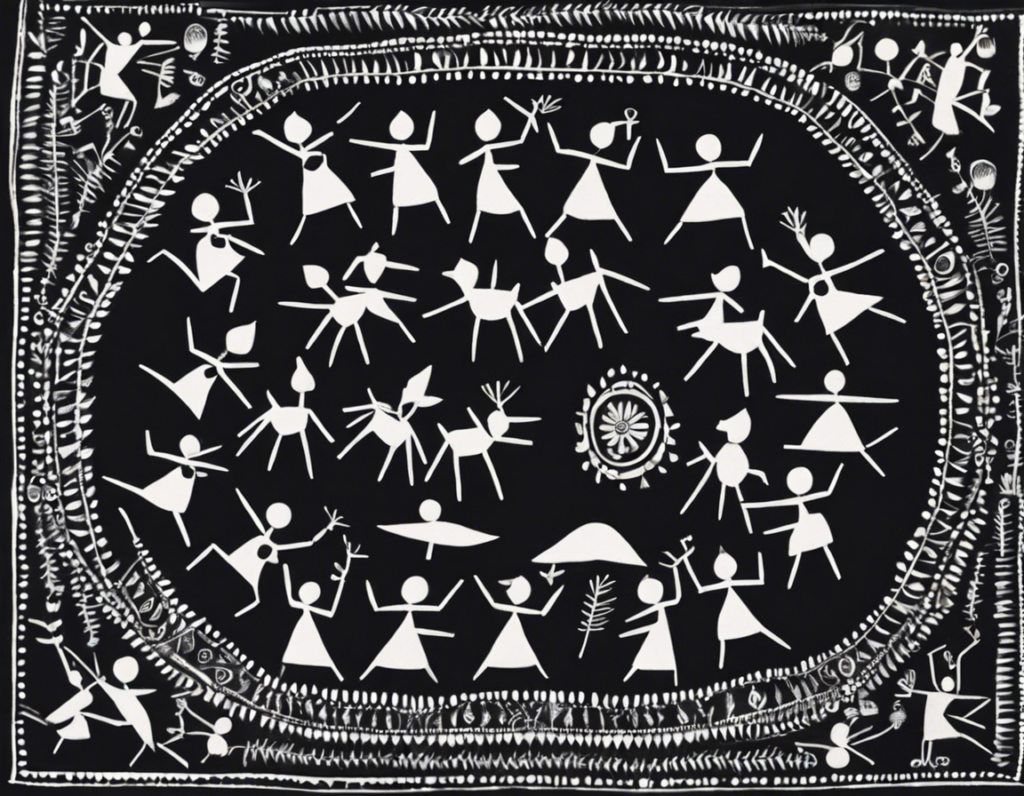Warli art is a mesmerizing form of tribal art that has its roots in the Warli tribe of Maharashtra, India. As one of the oldest forms of tribal art in the world, Warli art is known for its simplicity, elegance, and earthy charm. The art form primarily consists of creating stunning black and white paintings that depict elements of daily life, rituals, and nature using basic shapes like circles, triangles, and lines. Warli art is deeply rooted in the tribe’s culture and traditions, making it a timeless and beautiful form of artistic expression.
Origins and History of Warli Art
The origin of Warli art can be traced back to as early as the 10th century A.D., with its roots entrenched in the Warli tribe’s ancient customs and beliefs. The art form is traditionally created by the tribal women of the community, who paint the walls of their mud houses with intricate designs during special occasions and festivals. These paintings serve as a form of storytelling, depicting scenes of everyday life, tribal folklore, and the tribe’s intimate connection with nature.
Technique and Style of Warli Art
The hallmark of Warli art lies in its simplistic yet powerful style. Artists use a white pigment made from rice paste, along with a bamboo stick as a brush, to create intricate patterns on a dark background. The motifs used in Warli paintings often include geometric shapes such as circles and triangles to represent elements like trees, animals, human figures, and the sun and moon. The use of basic shapes and lines gives Warli art a distinctive and striking aesthetic appeal.
Themes and Symbolism in Warli Art
Warli art is rich in symbolism and often reflects the tribe’s close relationship with nature and their spiritual beliefs. Common motifs found in Warli paintings include the depiction of nature elements like trees, birds, and animals, as well as human figures engaged in activities like dancing, hunting, and farming. These symbols not only add visual interest to the paintings but also carry deeper meanings related to the tribe’s cultural heritage and worldview.
Evolution and Contemporary Relevance of Warli Art
While Warli art has its origins in ancient tribal customs, it has evolved over the years to adapt to changing times and tastes. Today, Warli paintings are not only found on the walls of tribal homes but have also gained recognition as a popular art form in the mainstream art world. Contemporary artists have experimented with different mediums, colors, and styles to give a modern twist to traditional Warli art, making it accessible to a wider audience.
Significance of Warli Art in Modern Times
In today’s fast-paced and technology-driven world, Warli art serves as a gentle reminder of the beauty and simplicity of rural life. The art form’s focus on nature, community, and spirituality resonates with people seeking a deeper connection to the world around them. Warli art has also found its way into various forms of products and merchandise, including clothing, home decor, and accessories, making it a popular choice for those looking to add a touch of ethnic charm to their lives.
Tips for Creating Your Own Warli Art
If you’re inspired by the beauty of Warli art and would like to try your hand at creating your own masterpiece, here are a few tips to get you started:
- Start with simple designs and motifs like trees, birds, and human figures.
- Experiment with different shapes and sizes to add visual interest to your artwork.
- Use a fine-tipped brush or a bamboo stick to create intricate patterns and lines.
- Practice creating balanced compositions and spacing to achieve a harmonious overall look.
- Don’t be afraid to experiment with colors and textures to give your Warli art a unique twist.
Frequently Asked Questions (FAQs) about Warli Art
- What materials are traditionally used in Warli art?
-
Traditional Warli art is created using a white pigment made from rice paste, along with a bamboo stick as a brush. The paintings are typically done on a dark background to create a striking contrast.
-
What are the common themes in Warli art?
-
Common themes in Warli art include nature elements like trees, animals, and birds, as well as human figures engaged in daily activities. These motifs often carry symbolic meanings derived from the tribe’s cultural beliefs.
-
Is Warli art only done on walls?
-
While Warli art traditionally adorns the walls of Warli tribe homes during special occasions, contemporary artists have explored various mediums such as canvas, paper, fabric, and even digital platforms to showcase their creations.
-
What is the significance of geometric shapes in Warli art?
-
Geometric shapes like circles and triangles are central to Warli art as they represent elements of nature, community, and spirituality. These shapes help convey intricate tales and messages in a visually appealing manner.
-
Can anyone learn to create Warli art?
- Yes, Warli art is an accessible art form that can be learned by anyone interested in exploring its beauty and cultural significance. There are workshops, online tutorials, and books available to help beginners get started with creating their own Warli masterpieces.
In conclusion, Warli art is a timeless and enchanting form of tribal art that continues to captivate art enthusiasts around the world. Its simplicity, elegance, and rich symbolism make it a unique expression of the Warli tribe’s cultural heritage and artistic prowess. Whether you’re a seasoned artist or a novice looking to explore a new art form, Warli art offers a blend of tradition and modernity that is sure to leave a lasting impression.
